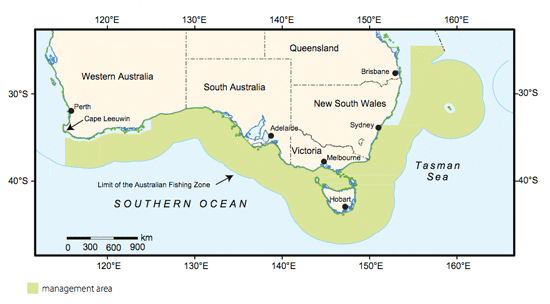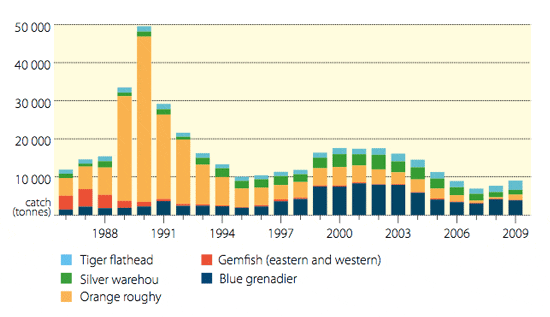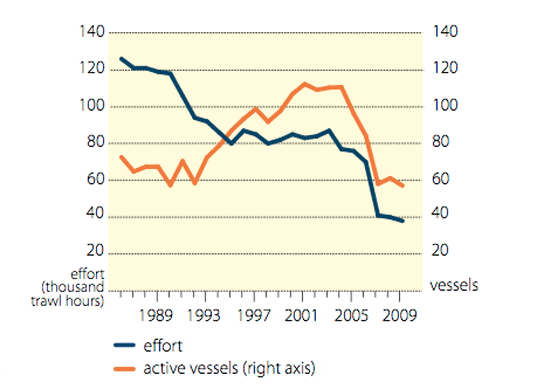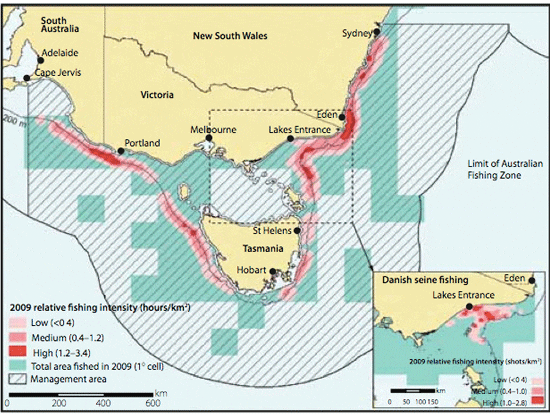Overview of the fishery
Overview of the Southern and Eastern Scalefish and Shark Fishery
The Southern and Eastern Scalefish and Shark Fishery (SESSF) is a multi-sector and multi-gear fishery targeting scalefish and shark stocks. The management area extends from waters off southern Queensland to Cape Leeuwin in Western Australia (map 1), almost half of the waters in the Australian Fishing Zone (AFZ). The fishery operates in both Commonwealth and state waters under Offshore Constitutional Settlement arrangements with state governments. It is one of the largest Commonwealth-managed fisheries, with landings of around 20 000 tonnes in 2009 (Stobutzki et al. 2010a). In 2008–09, the gross value of production was $95.5 million, accounting for 30 per cent of the gross value of production of Commonwealth fisheries.
Map 1: Management area of the Southern and Eastern Scalefish and Shark Fishery

Overview of the Southern and Eastern Scalefish and Shark Fishery—Commonwealth Trawl Sector
The Commonwealth Trawl Sector (CTS) is a sector of the SESSF. It stretches from Sydney southwards around Tasmania to Cape Jervis in South Australia where it meets the Great Australian Bight Trawl Sector (map 2). It is a multi-species fishery that targets finfish using otter and mid-water trawl, and Danish seine. Major ports in the sector are Lakes Entrance and Eden. In 2008–09, the gross value of production of the sector was $54.3 million (Stobutzki et al. 2010b), making it the second most valuable Commonwealth fishery or sector. There were 51 active vessels in 2009, with total landings of 13 935 tonnes. Important target and by-product species include blue grenadier, eastern school whiting, flathead, gemfish, jackass morwong, pink ling and silver (spotted) warehou (figure 1). Both target and a number of by-product species have a total allowable catch (TAC).
Figure 1: Catch estimates for five TAC species for the Commonwealth Trawl Sector of the Southern and Eastern Scalefish and Shark Fishery, 1986–2009

Figure 2: Estimates of effort and number of active vessels for the Commonwealth Trawl Sector of the Southern and Eastern Scalefish and Shark Fishery, 1986–2009

Fishing activity in the Commonwealth Trawl Sector is mainly affected by quota levels, weather and economic drivers such as fuel, fish and quota prices. Total fishing effort in the sector peaked at 112 000 hours in 2001 and effort remained above 100 000 hours until 2005 when it dropped to 96 000 hours (figure 2). Total effort decreased further to 58 000 hours in 2007, after 59 boat Statutory Fishing Rights were removed from the fishery (half of the number in the sector), under the structural adjustment component of the Securing Our Fishing Future package (Vieira et al. 2010).
Some of the key commercial target species are also taken by recreational fishers, but in smaller quantities than the CTS. These include deepwater and tiger flathead, and blue warehou (Griffiths et al. 2006).
Map 2: Management area and the 2009 relative fishing intensity for the Commonwealth Trawl Sector of the Southern and Eastern Scalefish and Shark Fishery

Potential effects of climate change on target species
The predicted strengthening and expansion of the East Australian Current and associated eddies may influence the distribution and availability of species on the east coast. Warm-core eddies in the East Australian Current, and the current’s separation from the continental shelf, play an important role in determining the location of gemfish aggregations (Prince and Griffin 2001). The strengthening and expansion of the East Australian Current occurs in association with the increase in sea surface temperature predicted for south-eastern Australia (Hobday et al. 2008). This may lead to the southward shift in the distribution of some species.
The westerly winds that are dominant in southern Australia are contracting southwards (CSIRO and BOM 2007). Decreases in wind speed of two to five per cent in the area from the Great Australian Bight to the southern Tasman Sea are predicted (CSIRO and BOM 2007). These winds play an important role for fisheries in the region; the weakening of winds is likely to lead to poor recruitment for both fished and non-fished stocks (Hobday et al 2008). The exact reasons are not known but it is speculated that the winds affect larval transport and/or coastal productivity (Hobday et al. 2008).
Hobday et al. (2008) predicted that the greatest change in sea surface temperature (up to 2.5–3 °C by 2070) will occur in south-eastern Australia, in part due to the southward shift of zonal winds and expansion of the East Australian Current (Lough 2009). Long-term observational data (1944–2002) from Maria Island off the east coast of Tasmania have shown that sea surface has already increased in the region, rising by 2.28 °C per century (Ridgway 2007). An increase in water temperature is likely to have an impact on metabolic processes such as respiration, activity level, growth and reproduction (Lough 2009). It is also likely to have an impact on the distribution and abundance of parasites and diseases.
The projected increases in water temperature are also likely to result in a southward shift in distribution of temperate species and changes to community composition (Hobday et al. 2008). However, species are limited by how far south they can move, as they may be limited by the extent of the continental shelf and the distribution of prey. Changes in water temperatures in the demersal zone appear to vary according to location. Temperatures appear to be decreasing across much of the southern hemisphere and in mid-latitude areas of the northern hemisphere, but increasing in lower-latitude parts of both the Atlantic and Pacific Oceans (Thresher et al. 2007). Decreased water temperature is likely to have a negative effect on growth rates (Thresher et al. 2007).
Challenges and opportunities
As a multi-species fishery, the Commonwealth Trawl Sector may be resilient to climate change because fishers may be able to switch between target and by-product species as their availability and distribution changes. However, switching between quota species is currently constrained by individual transferable quotas.
As sea surface temperature increases, many species that live in shallower depths are predicted to move southwards to cooler waters. If there is a shift in the distribution of species, fishers from northern ports may have to travel further or shift home ports. This may make fishing less economically viable, although some fishers change home ports now. As in other trawl fisheries, fuel is a major cost for fishers in the sector (Hohnen et al. 2008). The availability of subtropical species to fishers from northern ports in the Commonwealth Trawl Sector may increase. As subtropical waters are generally less productive than temperate waters, total catches may decrease, which could affect prices and value of production.
Climate change could also affect recruitment, which would have a direct impact on catches in the Commonwealth Trawl Sector. Temperature has been demonstrated to have an effect on spawning in marine fishes, including the timing and success of spawning events and hatching, and egg production and survival (Booth et al. 2009). Increased sea surface temperature in the region could lead to a change to the timing of spawning and a southward movement of the spawning area, both of which would have implications for the timing and location of fishing (Booth et al. 2009).
Changes to the East Australian Current are also expected to affect the location and predictability of spawning, but the magnitude and direction of these influences is uncertain. This is important because some fishers in the sector target spawning aggregations, such as for blue grenadier. Currently, it is not known where adult blue grenadier go after spawning, and the influence of climate change on these movements might make it more difficult to discover.
Harris et al. (1988) reported links between catch rates, recruitment and quasi-decadal changes in west winds over south-eastern Australia. Variability in wind has been linked with recruitment pulses in scallops, abalone and some fish species (Thresher 2002, Jenkins 2005). Therefore, changes in prevailing wind circulation in south-eastern Australia may have a significant impact on certain stocks within the Commonwealth Trawl Sector.
Given the predicted susceptibility of south-eastern stocks to climate change and the current overfished status of several stocks, climate change may make more stocks susceptible to overfishing. Target and important by-product species in the sector are managed under TACs derived from stock assessments. To maintain stocks at appropriate levels and prevent stocks from becoming overfished, it is essential that stock assessments reliably estimate total biomass. Climate change impacts may make it more difficult to do so, especially as assessment models are frequently used in a way that assumes the stock will behave in a similar way to that in the past. Reliably estimating the total biomass of stocks, as well as rebuilding overfished stocks, is already challenging and may become more difficult with climate change impacts.
Issues for policy and management consideration
- Both the harvest strategy and stock assessments will need to accept that historical time series might not be a reasonable basis fo estimating the current or future carrying capacity under a changing climate. Fishery independent surveys, which have started for some species in the Commonwealth Trawl Sector, might help provide a fishery independent historical time series.
- There is a need to evaluate whether managers and researchers will be able to detect any changes due to climate change in the fisheries data already collected, and if so, on what time scale. While it’s unlikely to detect the changes that are solely due to climate change, the early detection of changes maximises the time to respond appropriately.
- The ability of fishers to switch target species (due to changes in distribution and availability as a result of climate change) depends on the availability of suitable quota and the amount of flexibility to trade it. There may also be issues surrounding the asset value of quota. It also depends on the suitability of the current gear.
- Current and future spatial closures and offshore constitutional settlement arrangements may need to be reassessed if species distributions change due to climate change.

